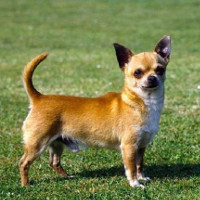Appearance of the Chizer
|
| Your Chizer may adopt the appearance traits of one or both of its parent breeds, the Chihuahua and the Miniature Schnauzer. Your pet is likely to be a small dog with large ears, probably with a docked tail and a long or short coat. However, he's sturdier than he looks, reaching an adult height of 15 to 35.5 centimeters and an adult weight of 2 to 7 kilos, depending on the dominant parental breed in the gene pool. Its head can be round, long or apple-shaped, with a well-developed black nose and large round eyes on a short, pointed or square muzzle with scissors or a slight underbite. Ears may be large, pointed and erect, or longer and floppy. Your Chizer will probably have a short neck on a slender body with long or short legs and a tail that may be naturally longer or have been docked. The coat will probably be short but may be longer, with softer hair on the head and slightly thicker hair on the body. Your dog's colors may be white, black, black and brown, black and white, black and tan, brown, chocolate, cream, dark brown, golden, gray and tricolor. |
Temperament of the Chizer
|
| Your Chizer may have the temperament traits of one or both of its breed parents, the Chihuahua and the Miniature Schnauzer. He's likely to be happy, gentle, playful, alert, kind, tolerant, intelligent and bold. He can be a little aggressive with small children who tend to tease him, and may not get on well with other animals and strangers. To moderate these traits, it's important to socialize him early in life. This hybrid will make an excellent addition to families without young children, or to families who can train him as a puppy to get along with young children. He can be shy around strangers, but this can also be moderated with appropriate early socialization. He will make an excellent watchdog, most likely following and monitoring every move when strangers are present, and whose energy levels are seemingly endless. They will bond closely with their human family, being a giver of a multitude of "kisses" and wanting to be by your side at all times. |
Needs and activities of the Chizer
|
| This cute, affectionate hybrid has seemingly endless energy, but can do well in an apartment or condo as long as it's exercised appropriately. They'll also do well in a home with or without a fenced yard, and can live in urban or rural settings. They can live in most warm climates but will shiver in the cold. Daily walks and physically and mentally stimulating games of fetch and Frisbee will provide your Chizer with its daily need for exercise. Daily exercise is very important as he tends to put on weight, which is unhealthy for him. |
Maintenance of the Chizer
|
| The Chizer's parent breeds, the Chihuahua and the Miniature Schnauzer, are both low-to-moderate excretors and will probably require brushing several times a week, with more frequent brushing during natural shedding periods. This will be important for households with family members who are asthmatic or have other respiratory problems. Bathing is required only when necessary. Ears should be checked and cleaned once a week to avoid infection. Teeth cleaning and dental examinations are also areas that need extra attention, as with many canine breeds. Proper follow-up and dental care will help avoid periodontal disease and the resulting tooth loss. |










 English (United Kingdom)
English (United Kingdom)